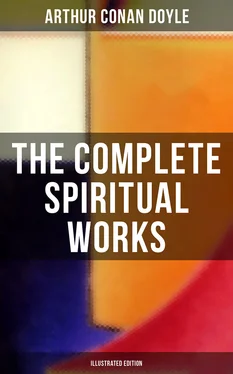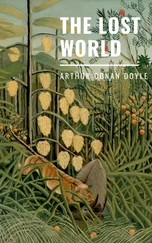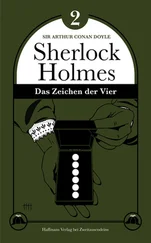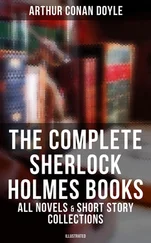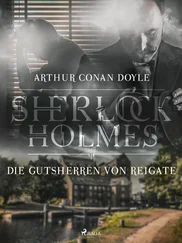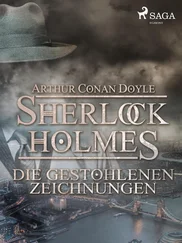Some people discountenance communication upon the ground that it is hindering the advance of the departed. There is not a tittle of evidence for this. The assertions of the spirits are entirely to the contrary and they declare that they are helped and strengthened by the touch with those whom they love. I know few more moving passages in their simple boyish eloquence than those in which Raymond describes the feelings of the dead boys who want to get messages back to their people and find that ignorance and prejudice are a perpetual bar. “It is hard to think your sons are dead, but such a lot of people do think so. It is revolting to hear the boys tell you how no one speaks of them ever. It hurts me through and through.”
Above all read the literature of this subject. It has been far too much neglected, not only by the material world but by believers. Soak yourself with this grand truth. Make yourself familiar with the overpowering evidence. Get away from the phenomenal side and learn the lofty teaching from such beautiful books as After Death or from Stainton Moses’ Spirit Teachings. There is a whole library of such literature, of unequal value but of a high average. Broaden and spiritualize your thoughts. Show the results in your lives. Unselfishness, that is the keynote to progress. Realise not as a belief or a faith, but as a fact which is as tangible as the streets of London, that we are moving on soon to another life, that all will be very happy there, and that the only possible way in which that happiness can be marred or deferred is by folly and selfishness in these few fleeting years.
It must be repeated that while the new revelation may seem destructive to those who hold Christian dogmas with extreme rigidity, it has quite the opposite effect upon the mind which, like so many modern minds, had come to look upon the whole Christian scheme as a huge delusion. It is shown clearly that the old revelation has so many resemblances, defaced by time and mangled by man’s mishandling and materialism, but still denoting the same general scheme, that undoubtedly both have come from the same source. The accepted ideas of life after death, of higher and lower spirits, of comparative happiness depending upon our own conduct, of chastening by pain, of guardian spirits, of high teachers, of an infinite central power, of circles above circles approaching nearer to His presence—all of these conceptions appear once more and are confirmed by many witnesses. It is only the claims of infallibility and of monopoly, the bigotry and pedantry of theologians, and the man-made rituals which take the life out of the God-given thoughts —it is only this which has defaced the truth.
I cannot end this little book better than by using words more eloquent than any which I could write, a splendid sample of English style as well as of English thought. They are from the pen of that considerable thinker and poet, Mr. Gerald Massey, and were written many years ago.
“Spiritualism has been for me, in common with many others, such a lifting of the mental horizon and letting-in of the heavens—such a formation of faith into facts, that I can only compare life without it to sailing on board ship with hatches battened down and being kept a prisoner, living by the light of a candle, and then suddenly, on some splendid starry night, allowed to go on deck for the first time to see the stupendous mechanism of the heavens all aglow with the glory of God.”
Supplementary Documents
I. The Next Phase of Life
Table of Contents
I have spoken in the text of the striking manner in which accounts of life in the next phase, though derived from the most varied and independent sources, are still in essential agreement—an agreement which occasionally descends to small details. A variety is introduced by that fuller vision which can see and describe more than one plane, but the accounts of that happy land to which the ordinary mortal may hope to aspire, are very consistent. Since I wrote the statement I have read three fresh independent descriptions which again confirm the point. One is the account given by “A King’s Counsel,” in his recent book, I Heard a Voice (Kegan Paul), which I recommended to inquirers, though it has a strong Roman Catholic bias running through it which shows that our main lines of thought are persistent. A second is the little book The Light on the Future, giving the very interesting details of the beyond, gathered by an earnest and reverent circle in Dublin. The other came in a private letter from Mr. Hubert Wales, and is, I think, most instructive. Mr. Wales is a cautious and rather sceptical inquirer who had put away his results with incredulity (he had received them through his own automatic writing). On reading my account of the conditions described in the beyond, he hunted up his own old script which had commended itself so little to him when he first produced it. He says: “After reading your article, I was struck, almost startled, by the circumstance that the statements which had purported to be made to me regarding conditions after death coincided—I think almost to the smallest detail—with those you set out as the result of your collation of material obtained from a great number of sources. I cannot think there was anything in my antecedent reading to account for this coincidence. I had certainly read nothing you had published on the subject. I had purposely avoided Raymond and books like it, in order not to vitiate my own results, and the Proceedings of the S.P.R. which I had read at that time, do not touch, as you know, upon after-death conditions. At any rate I obtained, at various times, statements (as my contemporary notes show) to the effect that, in this persisting state of existence, they have bodies which, though imperceptible by our senses, are as solid to them as ours to us, that these bodies are based on the general characteristies of our present bodies but beautified; that they have no age, no pain, no rich and poor; that they wear clothes and take nourishment; that they do not sleep (though they spoke of passing occasionally into a semiconscious state which they called ‘lying asleep’—a condition, it just occurs to me, which seems to correspond roughly with the ‘Hypnoidal’ state); that, after a period which is usually shorter than the average life-time here, they pass to some further state of existence; that people of similar thoughts, tastes and feelings, gravitate together; that married couples do not necessarily reunite, but that the love of man and woman continues and is freed of elements which with us often militate against its perfect realization; that immediately after death people pass into a semi-conscious rest-state lasting various periods, that they are unable to experience bodily pain, but are susceptible at times to some mental anxiety; that a painful death is ‘absolutely unknown,’ that religious beliefs make no difference whatever in the after-state, and that their life altogether is intensely happy, and no one having ever realised it could wish to return here. I got no reference to ‘work’ by that word, but much to the various interests that were said to occupy them. That is probably only another way of saying the same thing. ‘Work’ with us has come usually to mean ‘work to live,’ and that, I was emphatically informed, was not the case with them—that all the requirements of life were somehow mysteriously ‘provided.’ Neither did I get any reference to a definite ‘temporary penal state,’ but I gathered that people begin there at the point of intellectual and moral development where they leave off here; and since their state of happiness was based mainly upon sympathy, those who came over in a low moral condition, failed at first for various lengths of time to have the capacity to appreciate and enjoy it.”
Читать дальше
